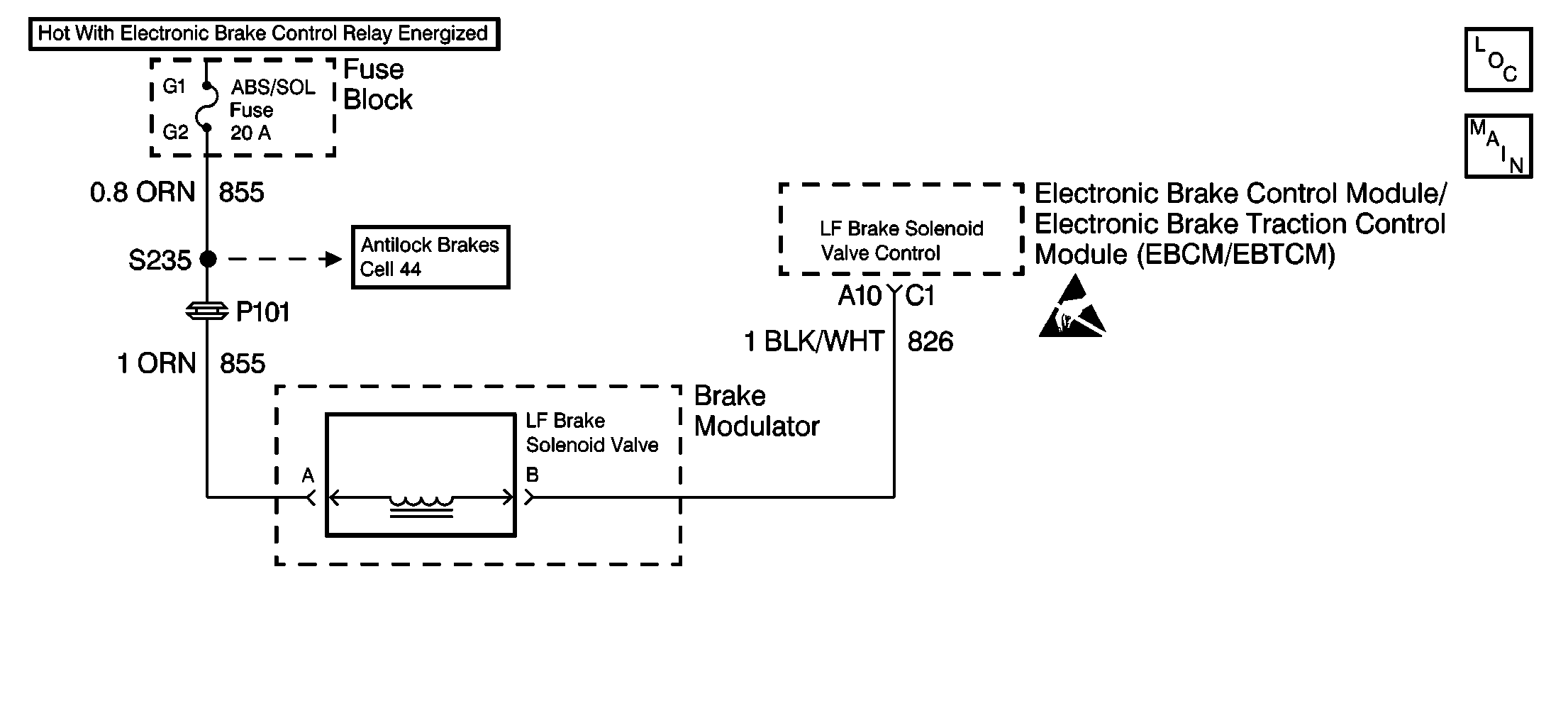
Circuit Description
DTC 1276 identifies a brake solenoid valve that cannot be energized. The malfunction may be caused by one of the following conditions:
| • | An open in the solenoid valve circuitry |
| • | The solenoid valve is always energized due to a short to ground in the solenoid valve circuitry between the driver and the brake solenoid valve. |
An open will not allow proper ABS operation but the short to ground simply turns on the brake solenoid valve. A path for base brakes is still allowed once the motor rehomes and the check ball is lifted off its seat during key to RUN initialization.
Conditions for Setting the DTC
DTC C1276 can set only when the brake solenoid valve is commanded off while the Electronic Brake Control Relay is enabled. A malfunction exists if the EBCM/EBTCM detects the left front brake solenoid valve control circuit voltage is not within specifications.
Action Taken When the DTC Sets
| • | A malfunction DTC stores. |
| • | The ABS/TCS disables. |
| • | The amber ABS/TCS warning indicators turn on. |
Conditions for Clearing the DTC
| • | The condition responsible for setting the DTC no longer exists and the Scan Tool Clear DTC function is used. |
| • | 100 drive cycles pass with no DTC detected. |
Diagnostic Aids
Use the enhanced diagnostic function of the Scan Tool in order to measure the frequency of the malfunction. Refer to the Scan Tool manual or Scan Tool Diagnostics located in this section for the procedure.
Thoroughly inspect any circuitry that may cause the intermittent complaint for the following conditions:
| • | Rubbed-through wire insulation |
| • | A broken wire inside the insulation |
| • | Backed out terminals |
| • | Improper mating |
| • | Broken locks |
| • | Improperly formed or damaged terminals |
| • | Poor terminal-to-wiring connections |
| • | Physical damage to the wiring harness |
Important: Zero the J 39200 test leads before making any resistance measurements.
Step | Action | Value(s) | Yes | No | ||||||||||||
|---|---|---|---|---|---|---|---|---|---|---|---|---|---|---|---|---|
1 | Was the Diagnostic System Check performed? | -- | Go to Step 2 | |||||||||||||
2 |
Is continuity to ground present during this test? | -- | Go to Step 12 | Go to Step 3 | ||||||||||||
3 |
Is the resistance within the specified range? | 0.0-2.0ohms | Go to Step 4 | Go to Step 14 | ||||||||||||
4 | Use the J 39200 in order to measure the resistance between the left front ABS brake solenoid valve connector terminal A and the left front brake solenoid valve connector terminal B. Is the resistance within the specified range? | 2.0-5.0ohms | Go to Step 5 | Go to Step 15 | ||||||||||||
5 | Use a J 39200 in order to measure the resistance between the electronic brake control relay harness connector terminal A2 and the left front brake solenoid valve connector terminal A. Is the resistance within the specified range? | 0.0-2.0ohms | Go to Step 6 | Go to Step 9 | ||||||||||||
6 |
Are terminal corrosion, damaged terminals, or poor terminal contact evident? | -- | Go to Step 16 | Go to Step 7 | ||||||||||||
7 | Inspect CKT 826 for damage. Damage which may cause a short to ground when the connectors are connected. Is there damage that may cause a short to ground with the connectors connected? | -- | Go to Step 17 | Go to Step 8 | ||||||||||||
8 |
Does DTC C1276 set as a current DTC? | -- | Go to Step 20 | Go to Step 21 | ||||||||||||
9 | Remove and inspect the ABS/SOL Fuse (20A) from the fuse block. Is the fuse OK? | -- | Go to Step 10 | Go to Step 18 | ||||||||||||
10 | Use the J 39200 in order to measure the resistance between the electronic brake control relay harness connector terminal A2 and the fuse block terminal G1. Is the resistance within the specified range? | 0.0-2.0ohms | Go to Step 11 | Go to Step 19 | ||||||||||||
11 | Repair the open in CKT 855. Is the repair complete? | -- | -- | |||||||||||||
12 |
Is continuity to ground present during this test? | -- | Go to Step 13 | Go to Step 15 | ||||||||||||
13 | Repair the short to ground in CKT 826. Is the repair complete? | -- | -- | |||||||||||||
14 | Repair the open or high resistance in CKT 826. Is the repair complete? | -- | -- | |||||||||||||
15 | Replace the left front brake solenoid valve. Is the repair complete? | -- | -- | |||||||||||||
16 | Replace all the terminals and connectors that exhibit the following conditions:
Is the repair complete? | -- | -- | |||||||||||||
17 | Repair the damage to CKT 826. Is the repair complete? | -- | -- | |||||||||||||
18 | Repair the short to ground in CKT 855. Is the repair complete? | -- | -- | |||||||||||||
19 | Repair the open or high resistance in CKT 1633. Is the repair complete? | -- | -- | |||||||||||||
20 | Replace the EBCM/EBTCM. Is the repair complete? | -- | -- | |||||||||||||
21 | The malfunction is intermittent or not present at this time. Is a concern still present? | -- | Go to Diagnostic Aids |
